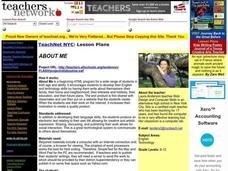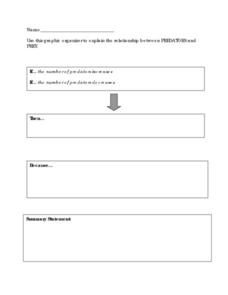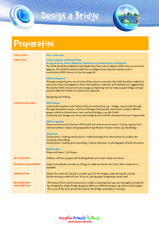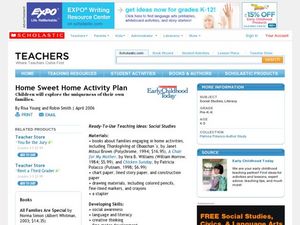Curated OER
Looking At Science And Technology From a Human Rights Perspective
Students answer discussion questions and analyze technological innovations, scientific discoveries, and environmental crises from a human rights perspective. They research and report back to the class about a related topic.
Curated OER
The Demographic Transition - A Contemporary Look at a Classic Model
Students examine classic demographic transition (DT) model, explain assumptions and limitations of model, construct graphs of contemporary demographic change, and explain contemporary demographic patterns in the context of the classic DT...
Curated OER
Antarctica
Students explore why Antarctica is so important to the planet. They investigate the physical characteristics. Students create their own unique treaty of governance for Antarctica and discuss how laws are enforced in Antarctica.
Curated OER
Think Before You Act
Students articulate their values regarding conduct toward others and to think about why they sometimes behave in ways that conflict with their values. They are provided with alternative ways to express their feelings and then in turn...
Curated OER
Building a Bully-Free Building
Students find a comfortable position in which they can relax and close their eyes. They listen as a portion from the Bully-Free School Guided Fantasy supplement is read and visualize the way a school without name-calling would look,...
Curated OER
The Rainbow Fish
Young scholars listen to The Rainbow Fish and select the correct meaning of the story from three examples presented by the teacher. They use a paper sclae to write three descriptive words about themselves.
Curated OER
Yut, a Traditional Korean Game
Students play a Parcheesi type game. They explore a new culture, to compare and contrast likenesses and differences in American and Korean families and leisure time and to experience a traditional Korean game. They identify where...
Curated OER
About Me
Students develop their English and technology skills by having them write about themselves--their family, their home and neighborhood, their interests and hobbies, their education, and their future plans. They produce an electronic text...
Curated OER
A Habitat Is Home
Students are introduced to the concept and components of a habitat. They discuss the key components of a habitat and describe how certain factors can cause disturbances in a habitat and change its population. Activities are leveled...
Curated OER
Predators and Prey
Students explain how the food chain works. They contrast predators with prey and describe their function in nature. Students discuss how the food chain aids in keeping nature balanced. In small groups, they play a game that simulates the...
Curated OER
Scales, Scutes, and Skins
Students identify the various adaptations of reptiles and amphibians. After distinguishing between reptiles and amphibians, students discuss the ways in which their adaptations aid in their survival. They participate in a hands on...
Curated OER
Exploring the Night Sky: Fall/Winter
Students explain how moon phases occur. They explain three ways that the night sky has been used through history. Students locate some of the constellations in the night sky. They discuss stories and myths surrounding stars.
Curated OER
Popcorn Science
Students identify and apply the scientific method through an experiment with popcorn. Then they identify what independent, dependent, and control variables are and create a list of different variables that affect popcorn popping....
Curated OER
Circulation
In this circulatory system worksheet, students design an experiment to test the circulation of six of their friends. They select and exercise to increase circulation, take pulse and blood pressure readings from each person before and...
Curated OER
Randomness and Information Worksheet
In this randomness learning exercise, students calculate the probability of certain things happening by completing 4 different word problems.
Curated OER
Likes and Dislikes: A Family in the 1950's
For this historical writing worksheet, students examine a full color picture of family life in the 1950's. Students write what they think they would like and dislike about living in this time from the viewpoint of the mother, father and...
Curated OER
Bridges- Design a Bridge
In this bridge design worksheet, students answer 5 general questions about bridges. Students follow the directions to construct 4 types of bridges with paper and test them for strength.
Curated OER
Easter Counting Worksheet
Students look at 4 squares and count the number of Easter baskets, eggs, bunnies and flowers found in each one. They write the number they counted in each square on the lines provided. A very good counting worksheet for young learners!
Curated OER
Social Change and Modernization
In this social change and modernization worksheet, pupils respond to 6 short answer questions and answer 6 multiple choice questions regarding these sociology topics.
Curated OER
Home Sweet Home Activity Plan
Students examine the uniqueness of their family. In this early childhood lesson plan, students develop social awareness, creative thinking, and fine-motor skills as they complete an activity regarding their families.
Curated OER
Atoms
In this atoms worksheet, students circle the term in parentheses that makes the 20 statements correct. The statements review the parts of an atom, isotopes, and basic matter principles.
Curated OER
I Dig Your Art, Man (or Woman)
Twelfth graders write a thesis regarding a modern artist of their choice for a 15-20 multi-media presentation. In this instructional activity students create a Power Point, video, or some other visual representation studying an artist or...
Curated OER
Contaminated Drinking Water
Students investigate drinking water. In this water lesson, students discover if the water we drink is safe by participating in an experiment. Students use water and vinegar to observe how drinking water can be contaminated.
Curated OER
Contaminated Drinking Water
Students discover whether their senses can detect unsafe drinking water. In the water activity lesson, students follow procedures to determine whether their bodies can detect contaminated water.























